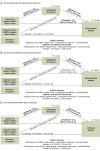Real-Time Exposure to Negative News Media and Suicidal Ideation Intensity Among LGBTQ+ Young Adults
- PMID: 39283650
- PMCID: PMC11406454
- DOI: 10.1001/jamapediatrics.2024.3133
Real-Time Exposure to Negative News Media and Suicidal Ideation Intensity Among LGBTQ+ Young Adults
Abstract
Importance: With a recent surge in anti-lesbian, gay, bisexual, transgender, or queer (LGBTQ+) policies and associated news and media coverage, there is a need to study the association of LGBTQ+ focused news or media exposure and short-term changes in suicidal ideation (SI) among LGBTQ+ youth.
Objective: To examine within-person direct and indirect associations between exposure to general and LGBTQ+ negative news or media and SI intensity through expectations of rejection.
Design, setting, and participants: This intensive longitudinal cohort study used a smartphone-based ecological momentary assessment (EMA) protocol wherein participants responded to EMAs 3 times per day for 28 consecutive days. Young adults aged 18 to 24 years who self-identified as LGBTQ+, resided in Tennessee, and had past-year SI and at least mild depression (defined as a score ≥5 on the Patient Health Questionnaire-9) were eligible for inclusion. Participants were recruited through social media advertisements, LGBTQ+ community organizations, and mental and behavioral health clinics. Participants were recruited between March 30, 2023, and August 23, 2023, and data analyses were conducted from August 28, 2023, through April 20, 2024.
Exposures: At each EMA, participants reported on recent exposure to negative news or media. A 3-level categorical exposure variable denoted (1) no news or media exposure (reference); (2) exposure to general negative news or media; and (3) exposure to LGBTQ+ negative news or media. Each EMA also assessed expectations of rejection due to LGBTQ+ identity on a scale of 0 (not at all) through 10 (very much).
Main outcomes and measures: Three primary outcomes assessed current (ie, "right now") intensity of active SI, passive SI, and self-harm ideation, each measured on a scale from 0 (not at all) to 10 (very strong). Multilevel modeling approaches were used to account for the hierarchical structure of EMA data, with assessments (level 1) nested within people (level 2). Linear mixed models and multilevel mediation models were used to examine within-person associations between exposure to negative news or media and the 3 primary outcomes, as well as the mediating role of expectations of rejection.
Results: Of 31 total participants, 22 were assigned female sex at birth (71%), and 16 (52%) self-identified as transgender or gender diverse. The median (IQR) participant age was 21 (18-22) years, and a total of 2189 EMAs were completed, with a median (range) compliance of 90.5% (41.7%-100%). At the within-person level, recent exposure to LGBTQ+ negative news or media was significantly associated with increased active SI (estimate [b], 0.14; 95% CI, 0.04-0.25; P = .009), passive SI (b, 0.23; 95% CI, 0.04-0.41; P = .02), and self-harm ideation (b, 0.13; 95% CI, 0.02-0.23; P = .02). No statistically significant associations were detected for exposure to general negative news or media. In multilevel mediation models, heightened expectations of rejection explained some of the total effect of exposure to LGBTQ+ negative news or media on active SI (23%) and passive SI (37%).
Conclusions and relevance: This intensive longitudinal cohort study found that SI intensity modestly increased in the hours immediately following exposure to LGBTQ+ negative news or media among LGBTQ+ young adults. These findings have timely implications for research and intervention, particularly within sociopolitical and geographic contexts where news or media coverage about LGBTQ+ topics is intensified.
Conflict of interest statement
Figures

Comment on
-
Negative LGBTQ+ News Media Means Bad News for LGBTQ+ Young Adult Mental Health.JAMA Pediatr. 2024 Nov 1;178(11):1101-1103. doi: 10.1001/jamapediatrics.2024.3130. JAMA Pediatr. 2024. PMID: 39283631 No abstract available.
References
-
- McNaughton-Cassill ME. The news media and psychological distress. Anxiety Stress Coping. 2001;14(2):193-211. doi: 10.1080/10615800108248354 - DOI
Publication types
MeSH terms
LinkOut - more resources
Full Text Sources
Medical
Research Materials
Miscellaneous

